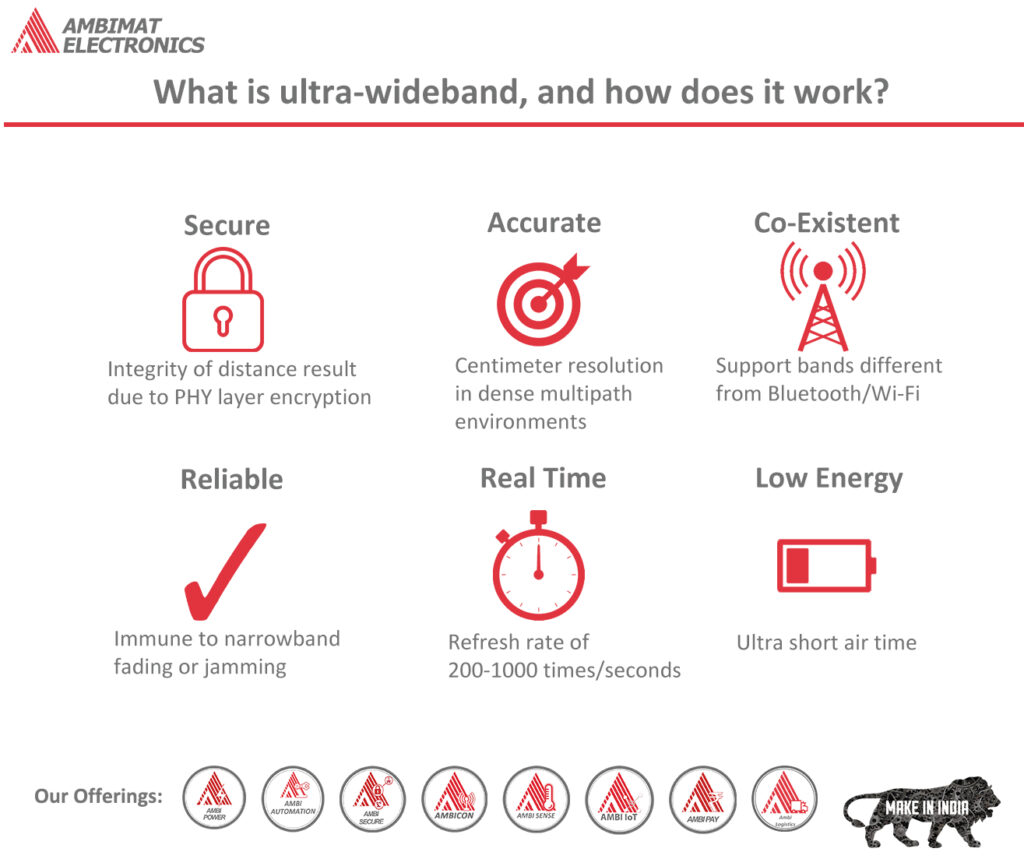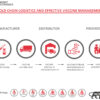Dear Readers,
This week’s blog is how Ultra-wideband or “UWB” is expected to enable technological advancement? What are the Most Important Fields of Application for UWB Technology?
Ambimat Electronics, with its experience of over four decades as an ODM of IoT products, wishes to draw the attention of its customers and readers of blog posts towards this upcoming field.
What Is Ultra-Wideband(UWB)?
UWB is a short-range, wireless communication protocol that – like Bluetooth or Wi-Fi – uses radio waves. But it differs substantially in that it operates at a very high frequency. As its name denotes, it also uses a wide spectrum of several GHz. One way to think of it is as a radar that can continuously scan an entire room and precisely lock onto an object like a laser beam to discover its location and communicate data.
Ultra-wideband (UWB) is a short-range wireless communication protocol—like Wi-Fi or Bluetooth—uses radio waves of short pulses over a spectrum of frequencies ranging from 3.1 to 10.5 GHz in unlicensed applications.
Developments in high-speed microprocessors and fast switching techniques have made UWB commercially viable for short-range, low-cost communication. Early applications include radar systems, communication, consumer electronics, wireless personal area networks, localization, and medical electronics. Since that time, detailed knowledge of UWB electromagnetics, components, and system engineering has been developed.
The low spectral density of UWB signals is attractive, making UWB less susceptible to in-band interference from other narrowband signals and very secure as they are difficult to detect due to low power density.
How does UWB work?
A UWB transmitter works by sending billions of pulses (UWB was previously known as “pulse radio”) across the wide spectrum frequency; a corresponding receiver then translates the pulses into data by listening for a familiar pulse sequence sent by the transmitter. Pulses are sent about one every two nanoseconds, which helps UWB achieve its real-time accuracy.
UWB is extremely low power, but the high bandwidth (500MHz) is ideal for relaying a lot of data from a host device to other devices up to about 30 feet away. Unlike Wi-Fi, however, it is not particularly good at transmitting through walls.
When a smartphone with UWB (like the latest iPhone) comes close to another UWB device, the two start ranging or measuring, their exact distance. The ranging is accomplished through “Time of Flight” (ToF) measurements between the devices; these are used to calculate the roundtrip time of challenge/response packets.
Based on the IEEE 802.15.4a standard, UWB can determine the relative position of peer devices with line of sight at up to 200 meters, according to the FiRa Consortium. The Consortium is currently adding a security extension – specified in IEEE 802.15.4z – to make it a “secure fine-ranging technology.”
Depending on the type of use, such as asset tracking or device localization, one of the UWB devices calculates the precise location of another UWB-enabled object – such as those car keys or television remote control that fell between the couch cushions. (If the device is running an indoor navigation service, the UWB-enabled device must know its relative location to the fixed UWB “anchors” and calculate its position on an area map.) With precise ranging, UWB has an advantage in both precision and security over Bluetooth and WiFi.
What are the possible uses for UWB?
UWB’s unique combination of signal characteristics — easy to identify, resistant to noise and reflection, separate from other signals — makes it an excellent choice for measuring distance and addressing a wide range of compelling new use cases.
The arrival of a detailed UWB specification, which includes dedicated security mechanisms and is designed for interoperability, means engineers can confidently begin work developing these new capabilities. Also, smartphone manufacturers and other makers of mobile devices are beginning to integrate UWB into their products. This helps widen the infrastructure for UWB services and build momentum for UWB features.
UWB will enable intuitive systems that blend seamlessly into daily routines. Hands-free access control will make it more secure and more intuitive to unlock doors and enter buildings. GPS-style location services, delivered indoors, will make it easier to navigate large spaces like shopping malls, educational campuses, and healthcare facilities. Device-to-device communication will enable smarter mobility in the home, retail, and enterprise applications.
UWB shows promise in automotive applications, where manufacturers are already demonstrating cars with UWB features. VW has demoed UWB-access to cars based on a UWB-enabled car key. BMW presented mobile car access with UWB in November 2019.
The lock on a car door can recognize your movements and unlock automatically, as you approach, while effectively resisting the relay attacks that cause issues in present-day smart-key designs. The Car Connectivity Consortium (CCC) serves as a standardization body for such car access solutions. The CCC’s website has outlined the enablement of hands-free smart car access in its CCC Release 3, which specifies Secure digital key management, automotive BLE for communication, and UWB technology for precise and secure localization. These supplements are set up to further develop the opportunities for smart device makers and vehicle manufacturers to enhance the evolving digital lifestyle.
About Ambimat Electronics:
With design experience of close to 4 decades of excellence, world-class talent, and innovative breakthroughs, Ambimat Electronics is a single-stop solution enabler to Leading PSUs, private sector companies, and start-ups to deliver design capabilities and develop manufacturing capabilities in various industries and markets. AmbiIoT design services have helped develop Smartwatches, Smart homes, Medicals, Robotics, Retail, Pubs and brewery, Security.
Ambimat Electronics has come a long way to become one of India’s leading IoT(Internet of things) product designers and manufacturers today. We present below some of our solutions that can be implemented and parameterized according to specific business needs. AmbiPay, AmbiPower, AmbiCon, AmbiSecure, AmbiSense, AmbiAutomation.
To know more about us or what Ambimat does, we invite you to follow us on LinkedIn or visit our website.
References:-
https://www.nxp.com/applications/enabling-technologies/connectivity/ultra-wideband-uwb:UWB
https://insights.samsung.com/2020/08/21/what-is-ultra-wideband-and-how-does-it-work/
https://www.sciencedirect.com/topics/engineering/ultra-wideband




